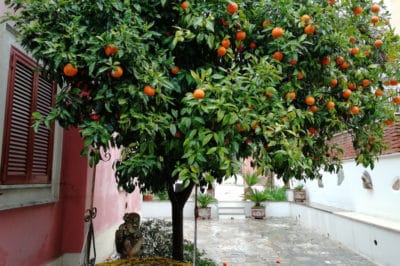What Orange Trees Look Like
Sweet and sour orange trees (Citrus sinensis, Citrus aurantium) share many identifying traits:
- Leaves: Both have glossy, oval yellowish-green leaves up to 6 inches long and 3 ¾ inches wide. The difference is that sour orange leafstalks (petioles) have tiny “wings.”
- Flowers: Both boast heavily fragrant, white spring flower measuring about 2 inches across. Each bloom has five oblong petals, from 20 to 25 stamens and very noticeable, golden-yellow anthers.
- Branches: Both have noticeably twisted young branches, often lined with thorns at the bases of the leafstalks. In most cases, the thorns disappear as the trees mature.
- Growth habit: Both have naturally rounded canopies, although navel sweet orange trees may droop from the weight of their crops.
- Fruit: Orange trees’ round, green fruit only becomes orange when exposed to enough cold. Thousands of glands filled with aromatic oil cover its pebbly rind. Its pulp ranges from yellow to — in the case of blood oranges — red or even purple. Oranges have from 10 to 14 juice-filled “sections” which may contain small, flat teardrop seeds.
Little-Known Orange Tree Facts
Besides providing some of the sweetest, healthiest fruit out there, orange trees have some surprising secrets:
- Only about 10 of every one thousand flowers an orange tree produces actually becomes a ripe orange. That’s just 1 percent.
- Orange trees’ fruit isn’t named for its color. The word “orange” has its roots in the Sanskrit word “naranga,” and that traces to the Tamu word ‘naru,” meaning fragrant. Stroll through an orange grove at the height of spring bloom, and you’ll understand why!
- Finally, the oranges themselves don’t get orange unless they’re exposed to temperatures below 55°F (12.7°C) long enough to break down their rinds’ green pigment. Called chlorophyll, it masks the orange anthocyanins underneath. The process is called degreening.
Expert gardener’s tip: Some parts of Brazil — the world’s top orange-growing country — never get cold enough for oranges to turn orange. Processing plants degreen them artificially before shipping them to market.
